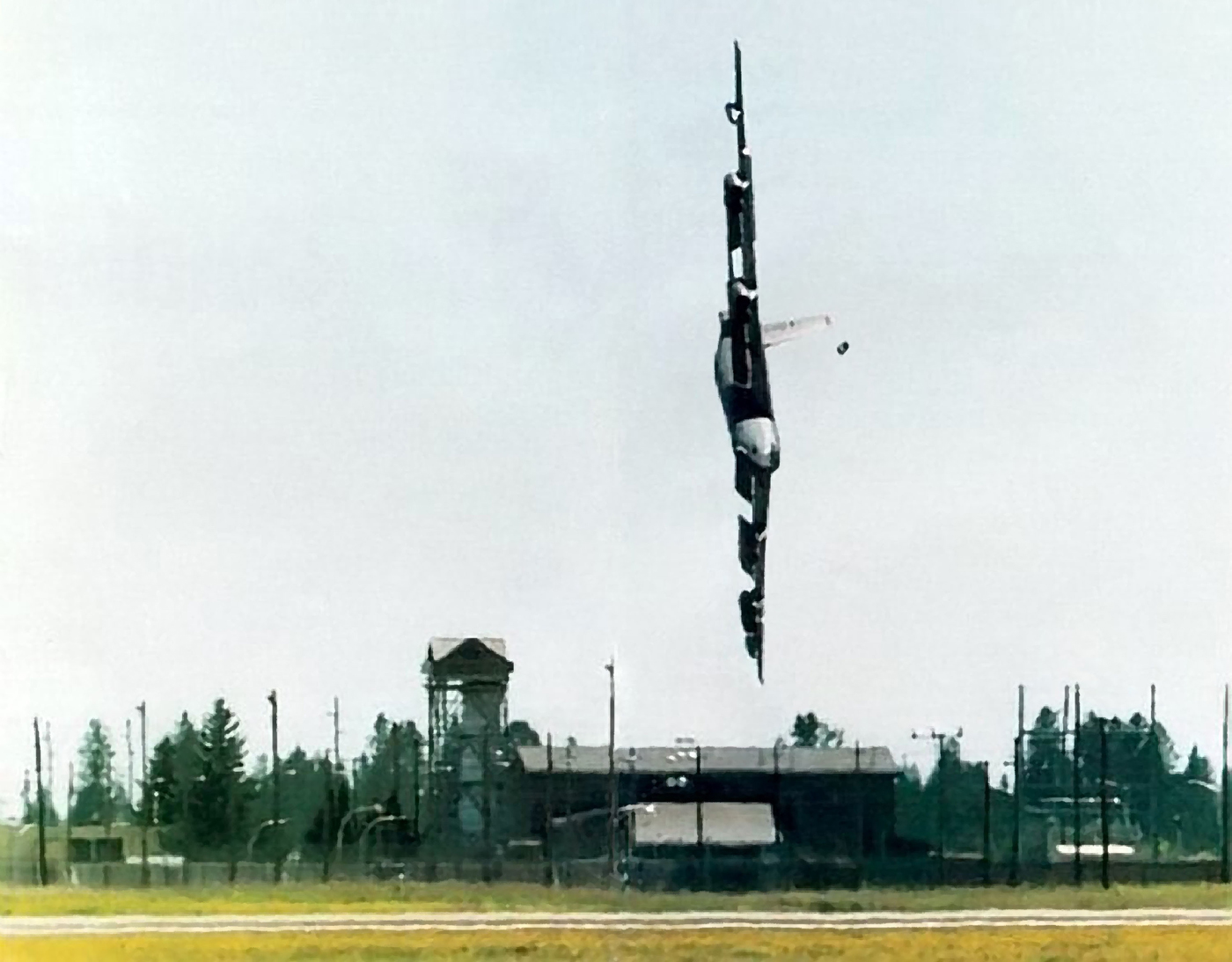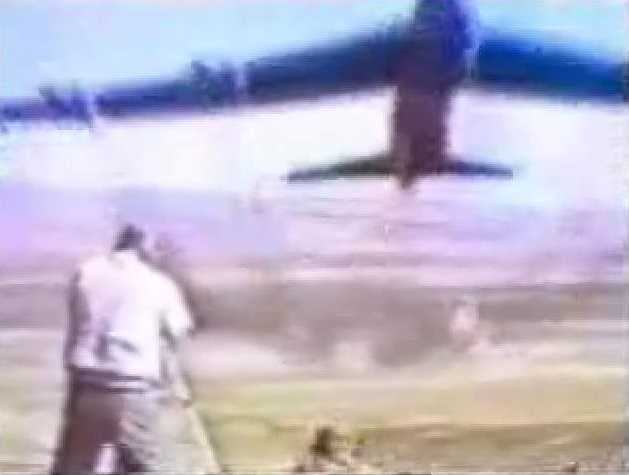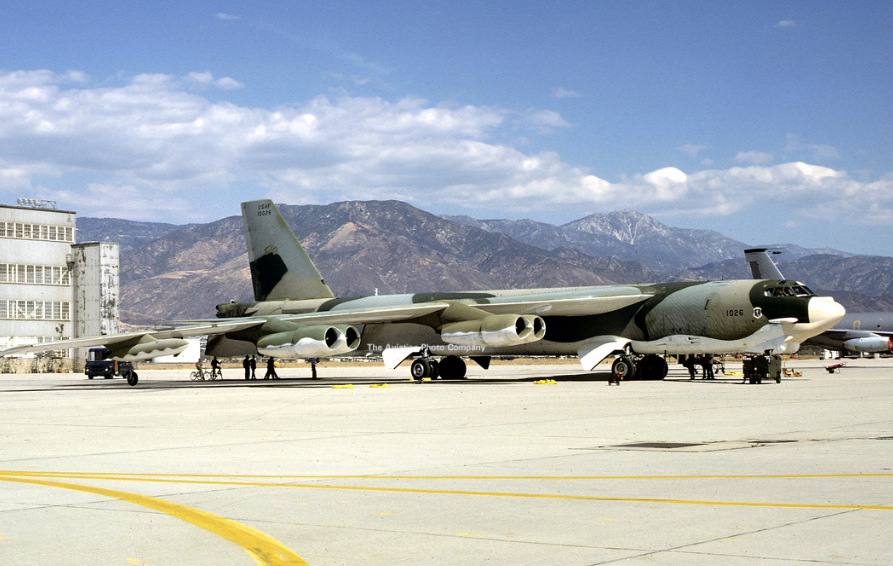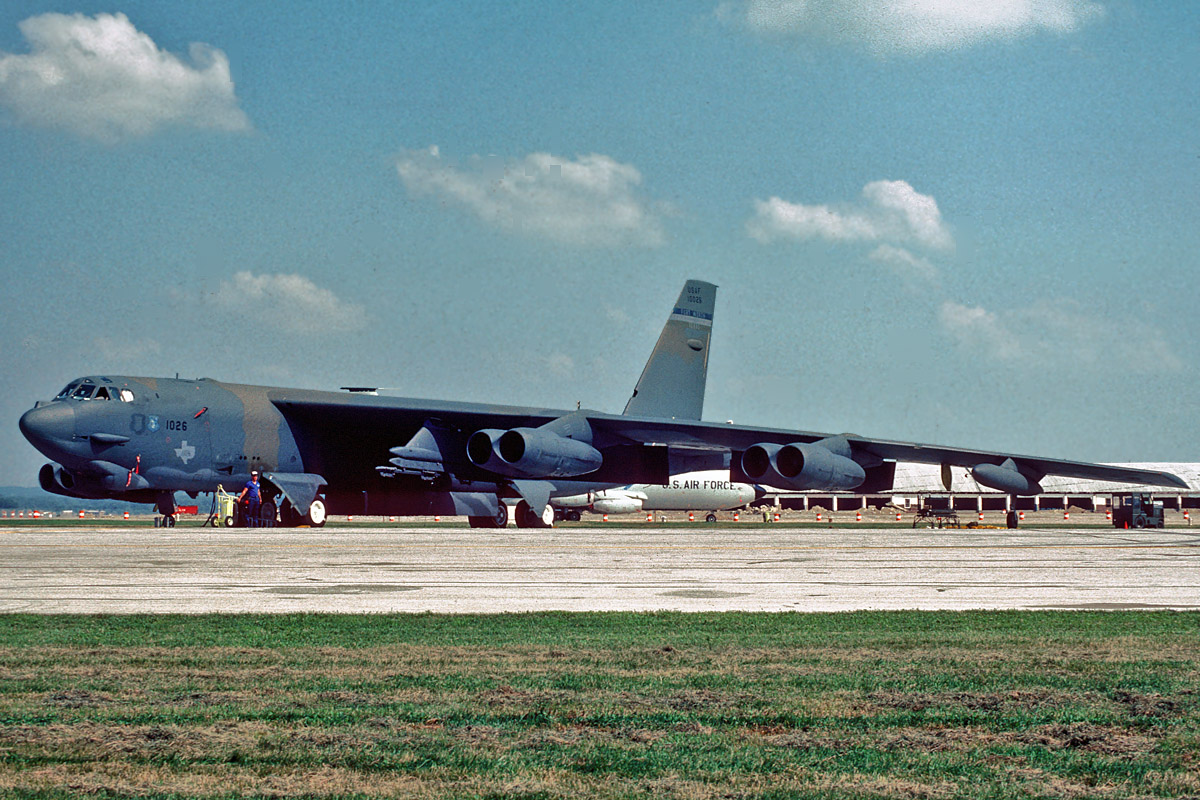
24 June 1994: At Fairchild Air Force Base, southwest of Spokane, Washington, a Boeing B-52H-170-BW Stratofortress, serial number 61-0026, call sign Czar Five Two, was being flown by Lieutenant Colonel Arthur Alan (“Bud”) Holland, the aircraft commander, with Lieutenant Colonel Mark C. McGeehan, commanding officer of the 325th Bomb Squadron, as the co-pilot. The vice commanding officer of the 92nd Bomb Wing, Colonel Robert E. Wolff, was aboard as the designated safety observer. The fourth crew member, Lieutenant Colonel Kenneth S. Huston, the 325th squadron operations officer, was the radar navigator.
The mission was a practice flight for an upcoming air show demonstration. During the 18 minute flight, virtually every maneuver performed by Lieutenant Colonel Holland exceeded the operating limitations of the B-52, and violated Air Force and Federal Aviation Administration regulations.¹
Bud Holland was notorious for his reckless flying. Many crew members had asked not to be assigned to fly with him. Many prior instances of dangerous flying had occurred. Officers in Holland’s chain of command were aware of these violations, but seemed to tolerate them. Only Lieutenant Colonel McGeehan had tried to have Holland grounded, but he was overruled.

Apparently, Holland thought that he was such a great pilot that he could make the B-52 do anything.
While approaching the runway for a touch-and-go, the control tower instructed Czar 52 to go around because of another aircraft that had just landed and was still on the runway. Holland requested to make a left 360° turn around the tower, which was approved.
At an altitude of just 250 feet (76 meters)—the B-52’s wingspan is 185 feet—Holland put the bomber into a nearly 90° left bank. As he approached the 270° point of the turn, Czar 52‘s wings went beyond the 90° point. Holland added power, but no amount of power could keep the B-52 in the air, now. The bomber simply fell out of the sky, impacting the ground with a 95° angle of bank and 150 knots (278 kilometers per hour) indicated air speed. Lieutenant Colonel McGeehan fired his ejection seat, but did not escape before impact. All four officers were killed.
The following You Tube video shows the actual crash of Czar 52. Other videos available on the internet show the entire air show practice, as well as previous examples of Holland’s dangerous flying.
The crash of Czar Five Two is an example of Command Failure. Everyone in the chain of command knew that Bud Holland was a dangerous pilot, but no one, with the exception of Lieutenant Colonel McGeehan, tried to stop him.
61-0026 was one of the last B-52 bombers built by Boeing before production ended in 1962. It was accepted by the U.S. Air Force on 2 June 1962.
The B-52H is a sub-sonic, swept wing, long-range strategic bomber. It was originally operated by a crew of six: two pilots, a navigator and a radar navigator, an electronic warfare officer, and a gunner. (The gunner was eliminated after 1991). The airplane is 159 feet, 4 inches (48.565 meters) long, with a wing span of 185 feet (56.388 meters). It is 40 feet, 8 inches (12.395 meters) high to the top of the vertical fin. The B-52H uses the vertical fin developed for the B-52G, which is 22 feet, 11 inches (6.985 meters) tall. This is 7 feet, 8 inches (2.337 meters) shorter than the fin on the XB-52–B-52F aircraft, but the fin’s chord is longer.
The wings of the B-52H have a total area of 4,000 square feet (371.6 square meters). The leading edges are swept aft to 36° 58′. The angle of incidence is 6°, and there is 2° 30′ dihedral. (The wings are very flexible and exhibit pronounced anhedral when on the ground.) To limit twisting in flight, the B-52H has spoilers on top of the wings rather than ailerons at the trailing edges.
The bomber has an empty weight of 172,740 pounds (78,354 kilograms) and its Maximum Takeoff Weight (MTOW) is 488,000 pounds (221,353 kilograms).

The most significant difference between the B-52H and the earlier Stratofortresses is the replacement of the eight Pratt & Whitney J57-series turbojet engines with eight Pratt & Whitney Turbo Wasp JT3D-2 (TF33-P-3) turbofans, which are significantly more efficient. They are quieter and don’t emit the dark smoke trails of the turbojets.
The TF-33 is a two-spool axial-flow turbofan engine with 2 fan stages, a 14-stage compressor section (7-stage intermediate pressure, 7-stage high-pressure) and and a 4-stage turbine (1-stage high-pressure, 3-stage low-pressure). The TF33-P-3 has a maximum continuous power rating of 14,500 pounds of thrust (64.499 kilonewtons) at 9,750 r.p.m., N1. Military Power, limited to 30 minutes, is 16,500 pounds (73.396 kilonewtons) at 10,000 r.p.m., N1. Each engine produces a maximum of 17,000 pounds of thrust (75.620 kilonewtons) at 10,050 r.p.m., N1, with a 5-minute limit. The TF33-P-3 is 11 feet, 4.32 inches (3.4625 meters) long, 4 feet, 4.93 inches (1.3442 meters) in diameter and weighs 3,900 pounds (1,769 kilograms).
The B-52H has a cruise speed of 456 knots (525 miles per hour/845 kilometers per hour). It has a maximum speed, with Military Power, of 555 knots (639 miles per hour/1,028 kilometers per hour) at 20,700 feet (6,309 meters)—0.906 Mach. The service ceiling is 46,900 feet (14,295 meters). The unrefueled range is 8,000 miles (12,875 kilometers). With inflight refueling, its range is limited only by the endurance of its crew.
The B-52H was armed with a 20mm M61A1 Vulcan six-barreled rotary cannon in a remotely-operated tail turret. The gun had a rate of fire of 4,000 rounds per minute, and had a magazine capacity of 1,242 rounds. After 1991, the gun and its radar system were removed from the bomber fleet. The flight crew was reduced to five.
The B-52H can carry a wide variety of conventional free-fall or guided bombs, land-attack or anti-ship cruise missiles, and thermonuclear bombs or cruise missiles. These can be carried both in the internal bomb bay or on underwing pylons. The bomb load is approximately 70,000 pounds (31,751 kilograms).
At the time of the crash, 61-0026 had a total of 12,721.5 hours on its airframe. It was the only B-52 remaining at Fairchild AFB and had been meticulously maintained and inspected. There were no discrepancies related to the accident. It was valued at $73,700,000.

Arthur Alan (“Bud”) Holland was born 7 September 1947, in Suffolk, Virginia. He was the son of Arthur Leroy and Virginia Holland.
Holland attended Campbell University, Bules Creek, North Carolina, where he was a cadet in Reserve Officers Training Corps. He received a commission as a second lieutenant, United States Air Force Reserve in January 1971.
Holland and his wife, Sarah Anne, had two daughters, Heather Lee and Mary Margaret.
At the time of his death, Holland had served in the U.S. Air Force for over 23 years. He was a rated Command Pilot with a total of 5,275.3 flying hours, with 5,038.3 hours in the B-52 series (61.1 hours combat, B-52G).
Holland’s remains were interred at Fairmont Memorial Park, Spokane, Washington.
¹ In the official U.S. Air Force Aircraft Accident Investigation Board report (AFR 110-14), the list of regulations and technical orders violated by Lieutenant Colonel Holland on this 18 minute flight takes up three full pages (Page 23, 24, and 25).
© 2018, Bryan R. Swopes
The video link doesn’t work…
Hmmmmm. . . I’ll see if I can find another video link.
https://www.youtube.com/watch?v=182AepOJjMs
Another link to consider. “Eye On America” with Scott Pelley follow up story.
https://www.youtube.com/watch?v=LgJl7b9bQH0
https://www.youtube.com/watch?v=182AepOJjMs
The level of passion in your writing leads me to think you might have been involved in the investigation? I lived in Seattle at that time, and I can remember some of the news reports.
Damn scary still shot of the final moments.
Thank you, Kevin. No, I wasn’t part of this investigation, but as a retired professional pilot, I cannot help but be angered by the totality of the circumstances. When you read the statements and complaints of crew members who had flown with Holland in the past, it is unbelievable that the officers in the chain of command had not grounded him and forced him out of the Air Force. Only one officer had tried to do this, and he was killed in this crash because he refused to allow any member of his squadron to fly with Holland unless he was also on board. As a chief pilot and chief flight instructor in commercial aviation, I have encountered pilots with similar personalities. They may be highly skilled, but they cannot be allowed to endanger passengers and crew, or persons on the ground, or damage very expensive machinery by ignoring known limitations and violating regulations. If they won’t change, you have to fire them, and advise appropriate authorities. Thanks for listening to me “rant,” Kevin.
I was pastor at Airway Heights Baptist Church when this happened. It effected many of our church members many who were bystanders.
Thank you, Robert.
Everything you stated is true. Mark was a friend of mine and did everything he could. Responsibility for his death, as well as the others, goes all the way through the Wing Commander to CINCSAC at the time. In the HQ, they nicknamed what they were trying to do ThunderBUFF. Complete failure of command leadership.
Thank you, Bill. I am very sorry for the loss of your friend, Lieutenant Colonel Mark C. McGeehan. He courageously put the safety of the aircrewman under his command first, and paid the ultimate price for his stand.
you repeat the command failure and it’s serial number paragraph twice
Thanks, Eric. I moved the paragraph, but forgot to delete it from the original position. I really do appreciate your corrections. —Bryan
Knowing how much the airlines like to hire ex USAF pilots, I can only say at least he didn’t do this to an airliner full of passengers. Imagine Holland pranging a 777 with about 400 people during a flashy go-around as he tried to make it turn like a Lear.
Aviation is a very small world and infamous individuals rarely get the call for an interview, let alone pass the extensive interview and ground training process.
No matter how skilled the pilot, the laws of aerodynamics and physics are immutable and transgressing them usually has dire consequences. Czar 52 remains a sad commentary on the arrogance of a pilot and the willful blindness of the command structure.
Nice. From what I read about YEARS ago – The Commanding General, asked for a Low-Level FlyBy. Despite repeated attempts by The Pilot, informing the General THAT, B-52s Were NEVER Designed for such maneuvers. The General Insisted, and fearing Termination, the Pilot tried. After the plane crashed, the Next Day, the Commanding General who Ordered The Stupid STUNT – placed his Rank on top of his Resignation Papers. Otherwise, the General was Going To Face Court Martial and Dismissal from the Air Force! Is Your Story, about Holla d – referring to The Incident I mention. Since, You are Putting A Lot of Fault – on That Pilot!!!!!!!!!
Robert, my article is based of the official U.S. Air Force accident report. (a) Colonel Holland was not a “junior officer,” but a senior officer, a command pilot, and the Wing’s B-52 standardization instructor. (b) Regardless of rank, the aircraft commander or pilot in command is the final authority as to the operation of that aircraft. (c) Colonel Holland was a known reckless pilot who should have been stopped long before this “accident.” (d) As a former chief pilot, I have little patience for subordinate pilots who exceed the aircraft limits and break the rules that have been established for everyone’s safety. They cause damage to, or loss of, valuable equipment, and risk the lives of people on the ground as well as any in the aircraft—including those who may fly that aircraft later.
You will find no sympathy for such reckless behavior from TDiA.
I used to be a Low Ranking Officer! If You want to Keep your Job, some Idiot Higher Rank may ask You to do something Totally Stupid. Just to make the SOB, feel Happy. Look at the Challenger, and Discovery shuttle disasters. Low Rank staff Tried To Warn supervisors of Problems. Those concerns were Ignored, because The Boss wants things done On Schedule! Then Boom, everything the Low Rank staffers tried to Point Out, did happen – and We lost more than 12 Astronauts, and 2 Multi-Billion dollars Shuttles because some Senior Supervisors, couldn’t handle The Truth!!!!!
This tale of woe and hubris and command failure puts me in mind of the website generated by an Air Force officer who was the Engineering Director for the NASA F-104N rocket assisted Starfighter and that officer’s experience with the apparent similar arrogance of the widely lionized pilot, dang it his name escapes me this evening, he flew into fame as the pilot of the X-1 and was made mythical by the movie, The Right Stuff and now i have found the name yes dummy Tom it is Chuck Yeager. I remember reading the website in detail five years ago and the Engineering Officer writes in detail of the loss of the F-104N by Chuck Yeager ignoring technical instructions and flying the aircraft as if it were merely some “souped up” Mustang which he flew in WW2. It is a damning indictment of Yeager and his attitude of reckless indifference to the knowledge of other officers of this specific and highly sensitive modified Starfighter.
Once again I visit your site and enjoy and admire your work. I was disappointed not to find the date of 6 June 1971 when the midair collison of an F-4B and a DC-9 took the lives of 49 people on the Hughes Air West passenger jet and the young pilot of the F-4B Phantom making its way back to MCAS El Toro on that fateful evening.
I would be delighted if you could make an entry on this. I several times have watched the Smithsonian Channel episode called “Speed Trap” which recounts this incident in detail.
I hope you are well and once again applaud your work and your site. Cheers and Happy Fourth of July!!!
After some minor effort on my part I found your entry for the Yeager crash in the NF-104 in 1963— 10 December 1963—-and also found the website for the full story according to the Engineering Director see his take and analysis at http://www.NF104.com.
If you have the time I would be interested on your reading and analysis of the episode as set out in the NF-104.com website. Cheers and enjoy the summer!!
Thomas, I have read the article you mention and found it to be very interesting.
On July 28, 2010, a C-17 was lost at Elmendorf in somewhat similar flight circumstances…practicing for the air show.
Bryan, thanks for the reply. Happy Writing. Cheers.
For anyone who flew the B-52 this incident is beyond belief . In my time in SAC Standboard pilots had spot promotions, were greatly feared and walked on water.
To add a small note: In the Fall of 1995 I was at South Com, HAFB Panama, near retirement with nothing to do. I fell into conversation one morning with an O-5 who seemed to have even less to do than me. One day I inquired about his duties and he said he was awaiting courtmartial. I think his name was Pelegrin and he said he was the wing vice commander at Fairchild. Sometime later I was told he got off with a fine and a reduction in rank.
I remember reading somewhere that someone on the crew had a pocket sized audio cassette recorder patched into the intercom and that the cassette was recovered. Supposedly, the last thing heard prior to impact was one of the other crewmen yelling, “You’ve killed us, you f**k!”
Chilling last words.
Only one thing missing when youre perpendicular to the ground. LIFT.
As if learning from errors is such a complicated thing. Seems rogue pilots with a god complex exist everywhere. My ex wife was friends with the entire crew. Their voiced concerns about the pilots ego went unheeded up the CoC.
https://en.m.wikipedia.org/wiki/1995_Royal_Air_Force_Nimrod_MR2_crash
This accident is horrible, not only due to the loss of life, but due to the fact that it was entirely preventable.
I wish the author would include the bio details of all the victims, and not just the pilot responsible.
For an outstanding description of this terrible incident read Warnings Unheeded by Andy Brown (WU Press, 2016).
An independent review of the incident titled A Darker Shade of Blue : A Case Study of Failed Leadership was written about this.
It is well worth your time to read the report
Like many, I have been intrigued by this accident over the years. As a former Naval Aviator and airline captain, my interest is not so much with the crash, but with how this man could keep being allowed to display such poor airmanship qualities by his superiors. A lot has been written on that. I commend Lt. Col. McGeehan for going after Holland; I commend him for personally taking the place of junior co-pilots on Holland’s flights; I have always wondered if McGeehan, as Holland’s superior officer and as his co-pilot on the day of the accident, ever tried to take control of the aircraft away from Holland as he exceeded flight limitations over and over again on that flight. Any airline flight crew member will tell you that you have that responsibility to take the aircraft away in the rare and unlikely event that the flying pilot is jeopardizing safety. I have a feeling that McGeehan was feeling he was fighting an uphill battle to get any support from the higher-ups to rein in Holland’s antics, so in awe they were of his macho — and utterly unsafe — practices. Squadron cultures can be healthy, or they can be toxic, depending on the leadership.
Well said, Captain Clifford. Thank you.
Bingo.
I remember a similar incident at GFAFB in the late ’70s or very early ’80s. Some hotshot pilot tried to do a “fighter peal out” in a B52H after a touch-n-go. They managed about a 50 degree roll at about 150 feet AGL. A couple of the base high rankers were outside and witnessed the maneuver. Only a couple of minutes later they were ordered to land. The scuttlebutt that filtered down said that they were severely chewed out and grounded for a period of time.
My whole maintenance team also witnessed it.
It’s an interminable leadership problem exemplified by The Abilene Paradox. People who see problems are unwilling or unable to report what they see for fear of retribution. When it is reported, the complainant faces retribution and leaders fail to make changes.
My father Lt.Col R S “Bud “Freeman was in the left seat for 68 years. From 16 to 84 he became a master aviator. WW2, Korea, Bay of Pigs, RVN. I remember in 1960 he installed seat belts in the family car, He had about 15,000 hours, some in the B52. He completed his aviation career accident free including 129 combat missions. No one under his command was ever injured. He missed a lot of promotions when he took all responsibility as an aircraft commander. At 21 he was the youngest man to command a B29 Superfortress. He “colored inside the lines” and no one ever convinced him to violate a safety regulation. He hit the pinnacle of his career as an Air Commando instructor pilot. He is gone now but it wasn’t an accident that got him. He almost outlived his favorite the DC3.
The only good thing to come out of this tragic incident is that it is now taught as a case study in failed leadership at the USAF PME school that all Captains must attend. At least it was already being taught as of 2002 when I was an instructor there until 2005.